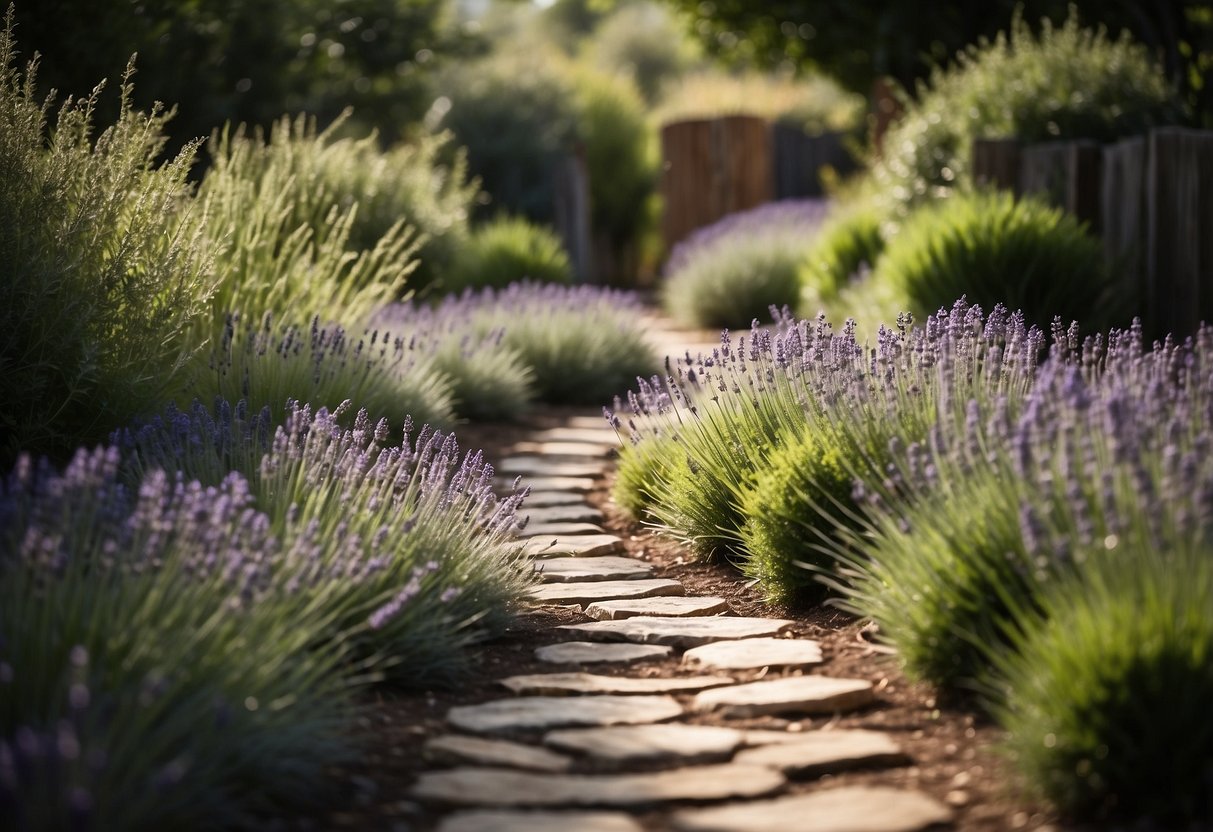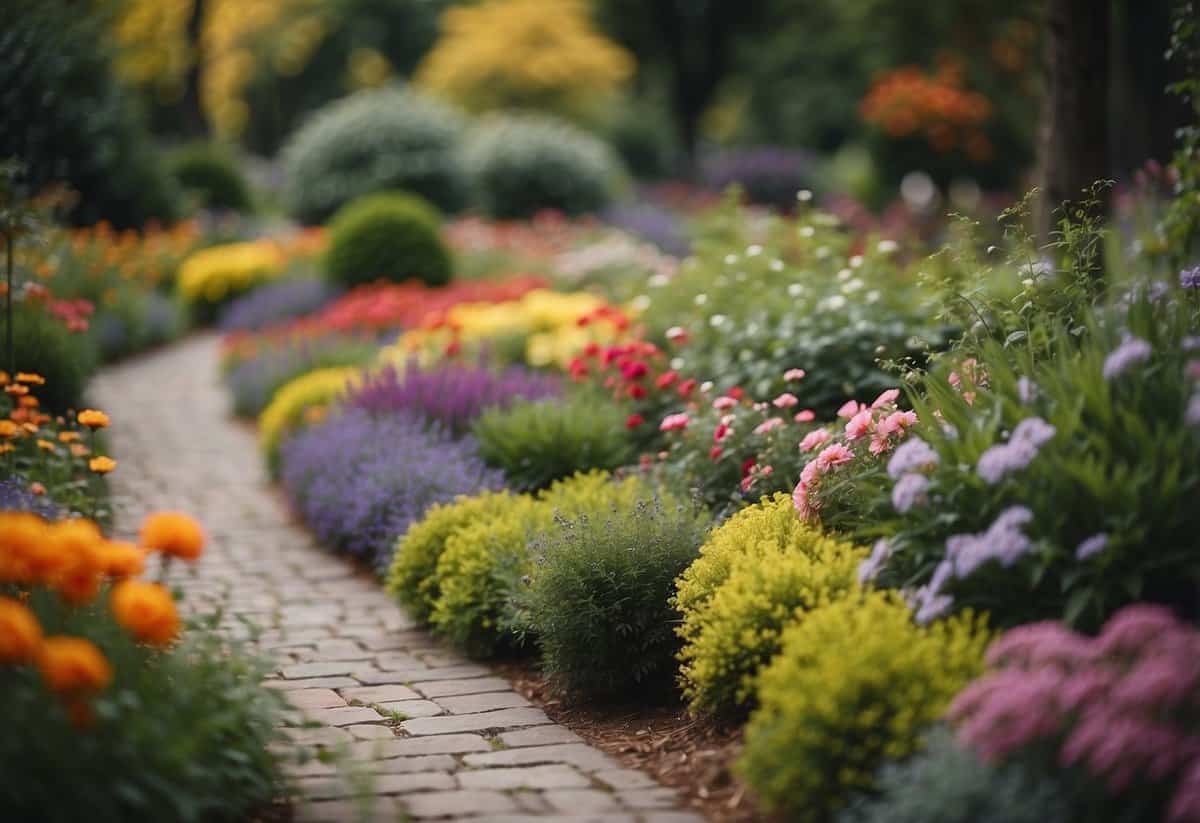Garden Path Ideas: Transform Your Outdoors with Creative Design
Creating a beautiful garden path can transform your outdoor space into a more inviting and organized area. Paths not only guide you through your garden but also add a touch of elegance and style to your yard. Whether you prefer a rustic, natural look or a more polished, modern design, there are countless options to explore.

How can you find the perfect garden path idea for your backyard? By considering different materials, styles, and designs, you can create a path that complements your garden’s unique features. From simple dirt paths to intricate stone walkways, there’s an option to suit every taste and budget.
1) Stepping Stone Path

Creating a stepping stone path in your garden can add charm and functionality. It’s an easy way to dress up a mulch pathway and give it a unique look.
You can mix standard stepping stones with more decorative ones to save money. For a fun project, consider pouring concrete and adding metal inlays or mosaic details to make each stone special.
Stepping stone paths are not only aesthetic but functional too. In areas with water concerns, use a rock base to build up and secure your stones. This allows water to flow around without washing away your path. Check out more ideas here.
2) Brick Border Pathway

Creating a brick border pathway adds charm to your garden. Bricks are sturdy and come in many colors. You can create patterns like herringbone or basket weave.
Use a shovel to dig a shallow trench. Lay the bricks edge to edge. Fill the gaps with sand or gravel. This helps keep the bricks in place.
For a curved path, you may need to cut some bricks to fit smoothly. Regular maintenance like sweeping will keep your path looking neat. You can find more tips here.
3) Herb Garden Walkway

Imagine walking through a path surrounded by fragrant herbs like rosemary, thyme, and lavender. An herb garden walkway not only adds beauty but also fills the air with delightful scents.
Use stepping stones or bricks to create the path. Line the edges with your favorite herbs to make it easy to harvest while you enjoy a leisurely stroll.
For a charming look, mix different types of herbs and let them grow naturally. This creates a lush, green walkway that invites you to pause and take in the fresh aromas.
4) Gravel Garden Trail

A gravel garden trail is simple and budget-friendly. These paths can be easily built and offer a natural look.
For a stylish touch, you can use a limestone border. This adds a bit of elegance without much extra cost.
You might also consider using landscape fabric to prevent weeds from growing through your gravel trail. This helps keep maintenance low. Learn more about creating gravel garden paths for inspiration.
5) Solar Lighted Path

Solar lights are a great way to brighten up your garden path. They are eco-friendly and easy to install. You can place solar stake lights along the sides of your path to create a warm and welcoming glow.
You might also like the idea of using dandelion solar lights for a magical touch. These lights are powered by the sun, saving you on electricity costs. Plus, they turn on automatically at dusk.
Solar lights can also help define the edges of your flower beds. They add curb appeal and can be found in many styles and colors to match your garden. Consider installing solar landscape lighting for both beauty and safety.
6) Zen Bamboo Walk

A Zen Bamboo Walk adds a simple and calming touch to any garden. It uses tall bamboo plants to create a serene path.
You can place stepping stones through the bamboo. This makes the walk feel more natural and inviting. The rustling sound of bamboo in the wind adds tranquility.
Use mulch or gravel to keep the path clean. You want to enjoy the walk without worrying about weeds. Keep the bamboo trimmed so it looks neat and tidy. Consider adding a small bench for a peaceful resting spot.
7) Flower Bed Edges

Creating flower bed edges is a great way to make your garden look tidy and neat. You can use materials like brick, stone, or even bamboo.
Brick edges offer a classic look and are very durable. Stone edges give a more natural feel and can blend well with most garden styles.
For a unique touch, consider using ceramic tiles. These can be upcycled from broken tiles and add a splash of color.
8) Rustic Wood Planks

Rustic wood planks give your garden a charming and cozy feel. They’re easy to install and can be made from recycled wood you already have.
Old planks from other projects can be repurposed to create a lovely path. Just lay them out in the garden and see how they transform the space.
Wooden paths feel natural and fit well with plants and flowers. They’re also a great way to use what you have and save money. For more ideas on using wood in your garden, check out these beautiful wooden garden paths.
9) Pallet Wood Path

Using pallet wood for a garden path is both cost-effective and attractive. Reclaimed wood gives your garden a rustic charm.
To begin, collect wooden pallets and measure them to fit your desired path width. Remove the bottom slats to expose support boards for better stability.
You may need to add extra support boards if necessary. Additionally, maintaining space for water runoff is crucial, so avoid tightly packed boards.
For a seamless look, consider embedding part of the boards into the sod. This approach ensures the path stays in place while fitting naturally into your garden landscape.
Creating a pallet wood path can transform your garden into a beautiful and functional space.
10) Succulent Border Pathway

Use succulents to line your garden path for a unique and low-maintenance border. These drought-tolerant plants stay green and vibrant through different seasons.
Place smaller succulents like hens-and-chicks or stonecrop along the edges. They add rich textures and colors to the pathway.
Incorporating a succulent border makes your garden path stand out while being easy to care for.
Benefits Of Garden Paths

Garden paths not only add beauty to your garden but also improve movement around your outdoor space. They can transform the look of your yard and make it more functional.
Enhancing Aesthetic Appeal
Garden paths can significantly boost the visual appeal of your garden. A well-designed path serves as a decorative element that can draw attention to specific plants and areas. For instance, using wooden slats or flagstone can create striking contrasts with greenery and flowers.
Experimenting with different materials like timber and Corten steel can add a rustic or modern touch based on your style preference. Using gravel surrounding the path can enhance its clean look. Curved paths, like flagstone pathways, provide a natural, flowing transition through the garden.
Improving Accessibility
Garden paths make it easier to move through your yard, especially in larger gardens. Paved pathways prevent mud and grass from sticking to your shoes, keeping things clean. They also provide a firm, even surface to walk on, which is helpful for seniors or anyone with mobility issues.
A thoughtfully laid-out path connects areas like sheds, seating areas, and planting beds. Materials like concrete and stone ensure durability and low maintenance, making these paths long-lasting. These practical benefits make garden paths an essential feature for any garden.
Types Of Garden Path Materials

Choosing the right materials for your garden path can make a huge difference in both appearance and function. Here are three popular options: natural stone, gravel, and brick, each offering unique benefits.
Natural Stone
Natural stone paths add a timeless and elegant look to your garden. Stones like flagstone, bluestone, and slate are popular choices.
Flagstone is durable and comes in various colors. Bluestone is smoother and has a uniform look. Slate offers a rustic feel with its textured surface.
Using natural stone can be more expensive, but its durability makes it a long-lasting choice. To install, you’ll need to dig a foundation, lay a base of sand or gravel, and place the stones carefully. Joints can be filled with sand or small pebbles to keep the stones in place and prevent weed growth.
Gravel
Gravel paths are simple to install and budget-friendly. Gravel comes in different sizes and colors, perfect for matching your garden’s aesthetic.
To create a gravel path, start by removing any grass and leveling the area. Lay down a weed barrier fabric to prevent weed growth. Spread a base layer of large rocks or crushed stone for stability, followed by a top layer of smaller gravel.
Gravel allows water to drain easily, preventing puddles. It is also easy to maintain; just rake occasionally to keep it level and refill as needed.
Brick
Brick paths bring a classic, structured look to your garden. Bricks are highly durable and can be arranged in various patterns like herringbone, basketweave, or running bond.
For installation, dig out the path area, add a layer of sand or gravel, and set the bricks in your chosen pattern. Brick paths may require edging to keep the bricks in place and prevent shifting over time.
Bricks come in different colors and textures, allowing for creative designs. While they might be more labor-intensive to install, their strength and classic appearance make them a worthy investment for many gardens.
Using these materials can help you create beautiful, functional paths that enhance your outdoor space.
Designing Your Garden Path

When designing your garden path, it’s important to think about the layout and how lighting can enhance your garden’s look and usability. Plan carefully to create a beautiful and practical path.
Planning The Layout
Start by considering the purpose of your path. Is it for reaching a specific area, or simply to add beauty? Sketch out your garden, marking important spots and areas you want to connect.
Choose materials that match your garden’s style. For example, pebbles submerged in concrete create a sturdy and rustic path, while wooden slats with white gravel provide a modern look.
Think about the path’s width. Wider paths are better for main routes, while narrower ones are suited for decorative pathways. Consider curves and turns to add visual interest. Lastly, ensure proper drainage to avoid muddy spots and make the path safe to walk on.
Incorporating Lighting
Good lighting can transform your garden path, making it safer and more attractive. You can use solar lights along the edges for an eco-friendly option. These are easy to install and cost-effective.
String lights or lanterns add a whimsical touch, perfect for evening strolls. You may also consider LED spotlights to highlight specific features like plants or statues.
Remember to balance the light. Too much can be overwhelming, while too little may leave areas in shadows. Place lights at regular intervals, and if possible, opt for dimmable options to adjust the brightness as needed.
Make sure the lighting fixtures are weather-resistant to last through different seasons. This way, your garden path will be beautifully illuminated all year round.







